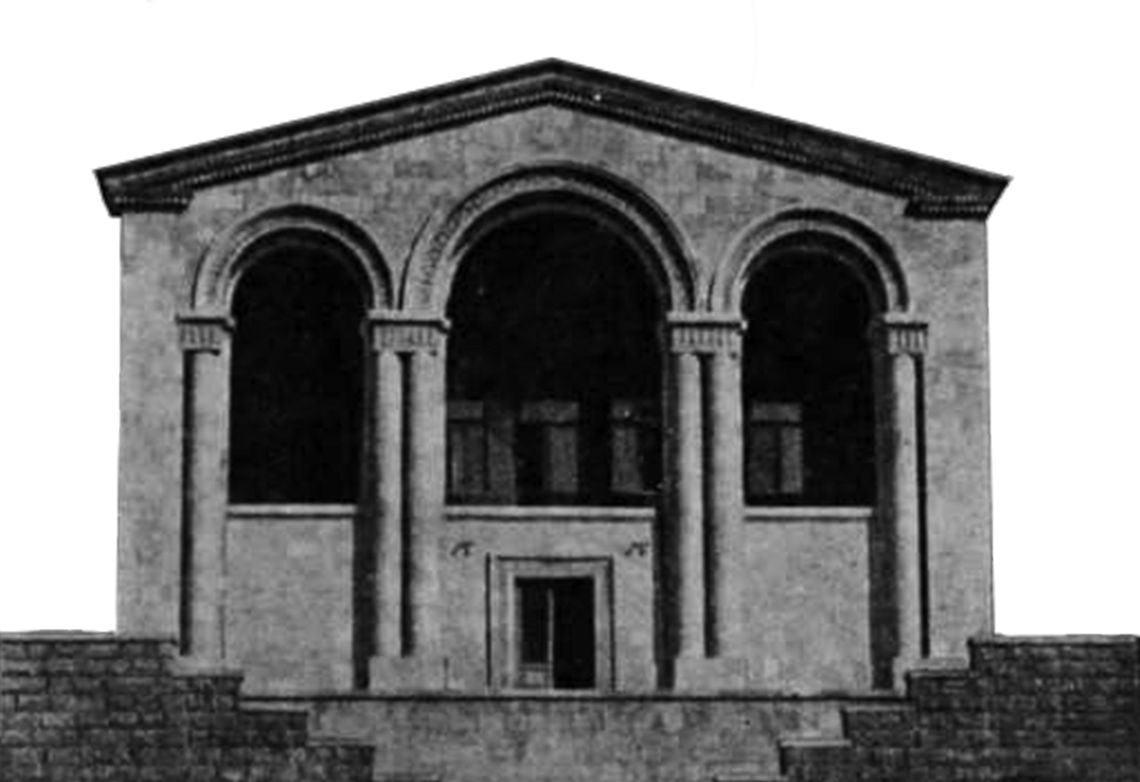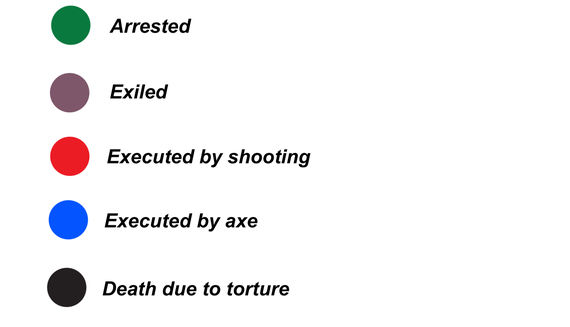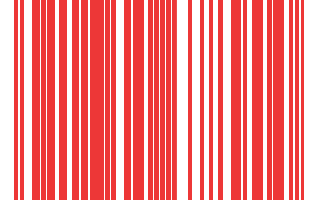
Armenia’s Ministry of Culture shut down an exhibit entitled ECLIPSE at the Tumanyan House Museum in Yerevan stating that it was ‘politicized’ and would need to be re-curated. The exhibit highlighted the severity of the repressions of the Stalin era in the 1930s known as the Great Purge. It was an era of extreme persecution, oppression and terror. Thousands of Armenians, including writers, artists, clergymen, intellectuals and many others were arrested, exiled and many were killed. Hovhannes Tumanyan, one of Armenia’s most revered writers lost three of his sons to Stalin’s oppressions.
The exhibit not only highlighted the repressions carried out by Soviet authorities, but also brought to the public’s attention the anti-Armenian actions by many Armenian statesmen of the time. Through historical correspondence around issues of national interest – Armenia-Turkey, the First Republic and Karabakh – the exhibit tried to put history into perspective by presenting archival material chronologically.
It remains unclear what the real motivations of the Culture Ministry were for shutting down the exhibit that was to run until late autumn. Since the public no longer has the opportunity to physically go and see the exhibit, Narine Tukhikyan, the director of the Tumanyan House Museum, provided EVN Report with all the curated artefacts so that it could live on virtually.
DEDICATED TO THE VICTIMS OF SOVIET TYRANNY
The exhibition tells the story of how the interests of Mustafa Kemal and the Bolshevik interests of Lenin and Stalin against Armenia and Armenians coincided.
How Armenian Bolsheviks became the zealous perpetrators of an anti-Armenian policy.
LUSTRATION
1917-1920-1926-1930-1934-1937-1941-1946-1949-1953
20..
HISTORY HAS A HABIT OF REPEATING ITSELF
From 1920-1953, more than 45,000 citizens of Armenia fell victim to Bolshevik repressions.
Including three of Hovhaness Tumanyan's sons.

From left to right
Artavazd Tumanyan (1894-1918)
During the hardest time for the Armenian people, he joined the army in Western Armenia. Murdered in 1918 in Van.
Moushegh Tumanyan (1889-1938)
By the 1937 decree of the Soviet dictatorial government, he was arrested and exiled to Taishet. A few months later in 1938, unable to bear the difficult conditions, died in exile.
Hamlik Tumanyan (1896-1938)
Was arrested by the Soviet regime in 1935. Six months later was set free. In 1937 was again arrested by the personal order of Beria and in 1938 was executed. The execution site is still unknown.
Areg Tumanyan (1901-1938)
Arrested by the Soviet regime in 1937. In 1938, he was executed by shooting near Moscow, in Butovo shooting square called “Kommunarka,” which was once the summer residence of Yagoda, a Bolshevik minister.
“ P.S. Everything could have been different had '37 not occurred. ”
Maria Sokalskaya-Tumanyan, widow of Mushegh Tumanyan
“I soon realized that the anti-Bolshevik movement actually arose in the villages and among the peasantry for whom Communist regulations and orders are alien and obscure… Since the [February] coup, no cases of executions of Communist friends imprisoned in Yerevan or among the captives have been recorded.”
Hovhannes Tumanyan to G. Atarbekyan, March 25, 1921 (excerpt from a letter )
-----------------------------------------------------------------------------------------------------------------------------------------------------
"Armenian chauvinists relying on the allies of imperialism, push forward a criminal idea – the creation of a “Great Armenia” on the borders of Historic Armenia. The absence of Armenians and the presence of an absolute Muslim population there does not concern them...our party cannot support the idea of either a “Great” or “Small” Turkish Armenia."
A. Mikoyan
December, 1919
“Lenin said that Russia cannot and does not want to fight against the Turks, chiefly for Kars, which, he thinks is a Turkish city. He says: ‘We temporarily sacrifice the interests of the Armenian working class for the sake of the interests of World Revolution…We are not ready to fight for Armenia against anybody, especially Kemal’”
A. Mravyan, member of the Armenia Rev. Committee, informs the commissar of the Foreign Affairs of Armenia A. Bekzadyan
"If we accept into the ranks of provincial officials only the half-educated, those who think only of their own well being, we will approach the state of political bankruptcy when total explosion will be inevitable. Everyone speaks of the 'beloved motherland,' everybody criticizes, but they have neither ability nor disposition to work. They appropriate... "
Letter of the governor of Kars, Stepan Ghorghanyan to the Prime Minister of the Republic of Armenia
February 29, 1920
"...demand either to unite the rebellious region (Ghazakh-Shamshadin) with Soviet Azerbaijan or to occupy it with the help of the Red Army…"
Amirkhanyan, Poghosyan
July 6, 1920
“…we cannot endlessly maneuver between the sides, we should definitely support one of them, doubtless, Azerbaijan with Turkey in this case. I have talked to Lenin and he has no objection.”
Stalin, telegram to Orjonikidze
July 8, 1920
"We suggest the following solution of the problem, which will satisfy Azerbaijan: Karabakh will completely and unconditionally join Azerbaijan…"
Orjonikidze, Legran
July 14, 1920, Baku
HIGHLY CONFIDENTIAL
(To be read at a closed meeting and burnt immediately after)
Kemalist Turkey is Soviet Russia’s ally and fights for its national freedom against Imperialism. The victory of Republican Armenia over Turkey will mean the strengthening of Imperialism in the Near East and will endanger the victory of the revolution in Transcaucasia and also the Sovietization of the East.
The goal of Armenian Bolshevik communists should be to accelerate the fall of the Republic of Armenia and draw the Sovietization of Armenia nearer.
For this very reason it is necessary
1-To dissolve the Armenian army
2-To organize desertion
3-To convince the soldiers not to shoot at advancing Turkish soldiers.
4-To refuse to obey the orders of the officers and eliminate them if necessary
Signed by members of the Central Committee of the Armenian Communist Party, S. Kasyan, A. Mravyan, A. Nurijanyan, Sh. Amirkhanyan, I. Dovlatyan, A. Hovhannisyan.
September 20, 1920, Baku
"The proletariat of Alexandropol and the deprived peasantry liberated from centuries old Armenian oppression send their fraternal and earnest welcome to the Turkish Communist Party ....
Long live the Turkish Communist Party
Long live the Red Revolutionary Army
Long live Communism
Long live Soviet Armenia"
A. Ter-Martirosyan, M. Khachikyan
November 13, 1920
"We must destroy the Armenian Army and the Armenian State."
Mustafa Kemal, 1920
…The first thing that caught the eye was the fraternal meeting of the Russian Red Army and the Turkish troops. Symbolic commonality could be found in the emblems of Turkish soldiers and officers – the Red Crescent and the ‘Badash’ Star…
Qyazim Karabekir promised to express his most sincere joy to the RSFSR [Russian Soviet Federative Socialist Republic] government on the occasion of the unification of the two armies.
Members of special commission, Abid Alimov, Suleyman-Kuri
December 20, 1920, Baku
"A most merciless war against the Dashnaks is the major aim of our revolution. Turkey's firm political conviction against the Dashnaks is strong enough to destroy them."
Avis Nurijanyan
December 20, 1920, Baku
"We assume that Mustafa Kemal's army fighting against Antanta…brings us freedom…"
M. Grigoryan, head of the Alexandrapol Revolutionary Committee
Revolutionary Committee delegates, N. Stepanyan, Kurdinyan, V. Mkhitaryan, N Zavaryan, S. Ter-Movsesyan, Z. Ashrafyan
A. Ter Martirosyan secretary-member
January 25, 1921
"In the near future a Georgian, Armenian and Anatolian Turkish Federation will be created and other countries of the East will join it."
Skachko A. Y., Armenia and Turkey at “The Life of Nationalities” conference
March 4, 1921
In March 1921, the Treaty of Moscow (or Treaty of Brotherhood) was signed between Soviet Bolshevik Russia and the Grand National Assembly of Turkey.
A few clauses from the Treaty of Kars concluded on October 13, 1921
-New borders were established between Armenia and Turkey defined by the Akhurian and Arax rivers. Turkey obtained the territory of the Kars province entirely, including the cities of Kars, Sarykamysh, Ardahan, Olti and Kaghyzman and the ruins of Ani (approximately 18, 000 km²). Turkey was also granted a large part of the Erivan province with the town of Surmali including Mount Ararat, to the south of Arax river with the towns of Ighdyr and Koghb (approximately 3.200 km²).
-Nakhichevan, which comprised the former Nakhichevan district and the Sharur part of the Sharur-Daralagezs district and the southernmost parts of the former Erivan Governorate, was officially declared an autonomous exclave under the political jurisdiction of Azerbaijan, on condition that the latter would not transmit it to any third party.
"The idea of gathering Armenians in Armenia, still thriving in the minds of the masses, should be urgently stopped. The absence of a land fund is the reason for developing nationalistic romanticism and makes Armenians long to take possession of their “ancestral lands.” It also keeps the idea of a “United and Independent Armenia” alive.
Hence we think it necessary:
a) To stop the idea of gathering Armenians in Armenia
b) To disperse the surviving 300,000 Western-Armenian refugees all over Russia"
Artashes Karinyan
1926 Economic Bulletin of the SSR of Armenia
"Karabakh, where Armenians form the majority of the population, has never been part of Azerbaijan, but the vital economic interests of the people of Karabakh call for joining it to Azerbaijan."
From the report of Armenian Bolsheviks sent to the 11th Army Military Committee
From 1923-1928
About 1500 officers who had fought for the independence of Armenia were exiled, shot or executed by axe.
Movses Silikyan, Tovmas Nazarbekyan, Atabek Bey Mamikonyan, Vardan Tellalyan, Makedon Ohanjanyan, Sergey Melik-Yolchyan, Hamazasp Srvanzdyan, Hrant Ter Margaryan, Levon Gengibaryan…
It was decided to execute the officers in a specific way - by axe. For this purpose, Armenian Bolsheviks relied on the professional skills of Turkish butchers of Yerevan’s Ghantar market.

from left to right
Hovhaness Kachaznouni-First Prime Minister of Armenia
Gurgen Edilyan-Public figure
Siragan Dikranyan-First Foreign Affairs Minister of Armenia
Hamazasp Srvantsdyan-National liberation movement member
Tevan Stepanyan-State, military figure
Cholo (Haroutyun Abrahamyan)-National liberation movement
Yeghia Choubar-Literary, public figure
Hrant Galigyan-Attorney, public figure
Grigor Chaghetyan-First Armenian Finance Minister
Nigol Aghbalyan-Political, public figure


from left to right
Hagop Zoryan-Historian, economist
Hrachia Ajaryan-Linguist, lexicographer
Morus Hasratyan-Director of the Matenadaran
Tatevos Avdalbegyan-Armenologist, linguist
Gevork Kochar-Architect
Mikael Mazmanyan-Honorary artist of Soviet Union, architect
Nerses Aginyan-Honorary professor of the University of Vienna
Mikael Yengibaryan-Provost of Yerevan State University
Gurgen Vanandetsi-Literary critic
Mgrdich Zanan-Actor, director
On July 9, 1928 Stalin's new doctrine to “strengthen the fight against class enemies” was proclaimed.
From 1930-1938
-14,904 people were repressed in Armenia
-4639 were sentenced to death
- 1882 were sent to concentration camps and labor colonies
Many of those sent into exile were repatriated Armenian Genocide survivors.

from left to right
Hovhaness Hakhverdyan-General Lieutenant
Tovmas Nazarbegyan-Military figure
Catholicos Khoren Mouradbekyan
Kristapor Araratyan-General Mayor of the Armenian Army
Guy (Haik Pjshgyants)-General Colonel
Garegin Njdeh-Armenian military and state figure
Armenag Khamperyants-USSR Aviation Marshal
Movses Siligyan-Military figure, national hero
Nicolay Ghorghanyan-National liberation movement
Ashkharhbeg Kalantar-Armenologist, archeologist
In 1934, after the 17th Congress of the Communist Party of the USSR, the Great Terror gained strength.
On December 15, 1937, the head of the NKVD (People’s Commissariat for Internal Affairs) N. Yezhov signed a special order N 004486 on “repressions against family members and children of traitors of the motherland.”
Under this order more than 1,250 Armenian women were subjected to repressions.
To Comrade Stalin,
"For the purpose of cleansing Armenia from anti-Soviet elements, Comrade Mikoyan asks the permission to execute another 700 people…I offer to execute 1500 people, that is 2000 in total with the previously approved number."
N. Yezhov, Head of the NKVD
September 9, 1937

From left to right
Vagharshag Novents (Yeritsyan)-Poet
Gurgen Mahari-Poet, writer
Vahram Alazan-Peot writer
Yeghishe Charents-Poet
Zabelle Yesayan-Writer, translator
Axel Bagunts-Writer, literary critic
Azad Vshduni-Poet, editor
Ler Kamsar-Satirist, writer
Vahan Totovents-Writer
Mgrdich Armen-Poet, writer
1937-1938
In the USSR, 25,342 children under the age of 15 (among them more than 700 from Armenian families) were repressed.
Up to the age of 1.5, they lived with their mothers in concentration camps, then were taken away and handed over to orphanages. New names were given to them. The Soviet authorities created “Children's Gulags” for the juveniles prone to anti-Soviet conduct.
From November 1,1937 to March 25, 1938, 6333 people were sentenced, 3639 among them were executed by shooting.
"...who have neither dignity nor joy to recognize and love their nation, who for a piece of unholy bread and their own primal welfare have always been with the foreign enemy."
Garegin Njdeh (Ter Haroutyunyan)
5th column and national shame
Anastas Mikoyan, Sargis Kasyan, Askanaz Mravyan, Avis Nurijanyan, Gevorg Atarbegyan, Ter Sahakyan, Artashes Karinyan, Dovlatyan, Khachik Mughdusi, Amirkhanyan, Nairi Zaryan, A.Hovhannisyan, Amirkhanyan, A. Mikvelyan , S. Ter Nakalov, A. Amatouni, A. Karnyan and many others...
The decree of December 10, 1940 allowed the execution of children by shooting from the age of 12.
Bolshevik methods of destroying people worked against the regime too. From Stalin to Khachik Mughdusi, they killed their allies with their very hands. But this is not all. They and others who were saved by the regime, for them lustration and posthumous disgrace awaits for their crimes against humanity.
The Armenian calamity caused by Lenin’s Bolshevism that came to power in 1917 in figures (Incomplete)
Complete deportation of Armenians from Western Armenia, (remaining 150,000)
Deportation of Armenians from Eastern Armenia:
Kars region -120,000
Akhaltsikhe - 30,000
Alexandrapol – 60,000
Ejmiatsin and Surmalu provinces - 80,000
Yerevan, Sharu and Nakhijevan provinces – 100,000
Batumi region - 20.000


